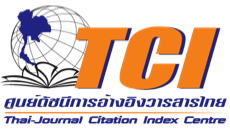ความเป็นธรรมทางการศึกษา: กรณีกองทุนเงินให้กู้ยืมเพื่อการศึกษา (กยศ.) ในระดับการอาชีวศึกษา ภาคตะวันออกเฉียงเหนือ ประเทศไทย (Educational Fairness: a Case of Student Loan Fund of Vocational Education in Northeastern Thailand)
คำสำคัญ:
ความเป็นธรรมทางการศึกษา/ กองทุนกยศ./ การอาชีวศึกษาบทคัดย่อ
การวิจัยนี้มีวัตถุประสงค์เพื่อวิเคราะห์การดำเนินนโยบายของกองทุน กยศ. ภายใต้กรอบคิดหลักความเป็นธรรมของ John Rawls (2001) ผู้วิจัยใช้ระเบียบวิธีทฤษฎีฐานราก (Grounded Theory) โดยใช้การวิจัยเชิงคุณภาพ ด้วยแบบสัมภาษณ์แบบมีโครงสร้างเพื่อสัมภาษณ์เชิงลึกกับลูกหนี้กองทุน กยศ. ในระดับการอาชีวศึกษา และวิเคราะห์ข้อมูลเชิงเนื้อหา โดยใช้วิธีการของความสอดคล้องต้องกันของข้อมูล
ผลการศึกษาพบว่า 1) มาตรการจัดเก็บเงินคืนของของกองทุน กยศ. ได้ใช้วิธีการเชิงบังคับ อันได้แก่ การกำหนดกรอบการชำระเงินที่ตายตัวและใช้มาตรการทำโทษที่เฉียบขาดรุนแรง รวมถึงเกณฑ์การผ่อนผันการชำระเงินได้ยกเว้นกรณีของลูกหนี้ทุพลภาพเพียงเท่านั้น ซึ่งขัดกับหลักสิทธิเสรีภาพขั้นพื้นฐานของ Rawls กลับกันมีเพียงการกำหนดอัตราดอกเบี้ยซึ่งในปัจจุบันอยู่ที่ 1% ที่ไม่ละเมิดหลักการดังกล่าว และ 2) ในส่วนของการกำหนดเกณฑ์การคัดเลือกผู้กู้ยืมได้ขัดกับหลักโอกาสที่เท่าเทียมกันของการเข้าถึงกองทุนฯ กยศ. ในขณะที่หลักการต่างๆเหล่านั้น ของกองทุนฯ ได้มุ่งเน้นไปยังกลุ่มด้อยโอกาสทางสังคม (Least advantage) สอดคล้องตามกรอบคิดของ Rawls
เอกสารอ้างอิง
Student loan Fund. (2013). “Annual report student loan fund”. [Online]. Retrieved November 25, 2016, from https://www.studentloan.or.th/en/system/files/files/knowledgemedia/247.pdf. (in Thai)
Barra, N., Chapman, B., Dearden, L., and Dynarsk, S. (2019). “The US college loans system: Lessons from Australia and England”. Economics of Education Review,71: 32-48.
Beattie, C. (1982). “Rawls and the Distribution of Education”. Canadian Journal of Education / Revue canadienne de l'éducation,7(3): 39-50.
BLT Bangkok. (2562). “Revealed more than 1.1 million debtors of civil service prosecutors aiming to deduct the salary of state-private workers by another three hundred thousand people”. [Online]. Retrieved August 9, 2019, from https://www.bltbangkok.com/article/info/8/1046. (in Thai)
Bøyum, S. (2014). “Fairness in education – a normative analysis of OECD policy documents”. Journal of Education Policy, 29(6): 856-870.
Brighouse, H. (2004). Justice. Cambridge: policy press.
Charoenkul, N. (2005). Equity in higher education. UK: University of Newcastle.
Gorard, S. et al. (2010). Equity in education; an international comparison of pupil perspectives. New York: Palgrave Macmillan.
Jantori, P. (2012). “Dual System Study – The Solution of the Thai Labor Crisis”. Journal of Business administration 35(135) : 29-39. (in Thai).
Mahacharoen, S. (2015). “Analysis of Student loan with interest rates on the back side of the business combination”. Journal of Management science Nakhon Pathom Rajabhat University 2 (1): 127-138. (in Thai)
Office of the Education Council, Ministry of Education. (2014). A report of Analysis of the results of the Thailand student loan for the accessibility and quality of education: a case study of Khon Kaen. Bangkok: Phrik Wan Krap Fik. (in Thai)
Office of the Permanent Secretary, Ministry of Social Development and Human Security. (2015). “Report on poverty, income and Household expenditures”. [Online] Retrieved March 4, 2017, from https://www.m-society.go.th/article_attach/15481/18817.pdf. (in Thai)
Patmasiriwat, D. (2009). “Educational Finance: Return to Higher Education and Educational loan Programs”. Economics and Public Policy Journal 5(5): 7-33. (in Thai)
Patmasiriwat, D. (2016). Economic inequality in Thailand. National Research Council of Thailand. (Unpublished Manuscript). (in Thai)
Phalipho, S., & Samakkhitham, S. (2011). Debt Problem of Student Loan Fund: A Case Study of Be in Arrears Person. [Online]. retrieved November 20, 2016 from http://mis.krirk.ac.th/librarytext/MPA/2554/No/Suprapol_Parlipho_2554.pdf. (in Thai)
Phuangprayong, K. (2011). The Evaluation of student loan fund: A case study of Vocational education institutions in Samutsongkhram Province. Master of Arts Thesis program in Social Development Administration NIDA. (in Thai).
Rawls, J. (1999). A Theory of Justice revised edition. Cambridge: Belknap press of Harvard University press.
Rawls, J. (2001). Justice as Fairness A restatement, edited by Erin Kelley. Cambridge: Belknap press of Harvard University press.
Schleicher, A. (2014). Equity, Excellence and Inclusiveness in Education Policy Lessons from Around the World, OECD.
Smith, E. (2010). Key Issues in education and Social Justice. London: SAGE Publication.
Strauss, A. and Corbin, J. (1998). Basics of Qualitative Research Techniques and Procedures for Developing Grounded Theory. 2nd ed. London: Sage Publications.
Yamyindee, P., Amdonkroy, S., & Jaicharad, N. (2013). “A Study on the Causes at Risk of Vocational Student dropouts of Bungphra Phitsanulok Commercial College, Office of Vocational Education Commission”. Journal of Graduate Studies in Northern Rajabhat Universities, 3(5): 1-14. (in Thai)
Zhang, H., Chan, P. W. K., & Boyle, C. (2014). OPENING PANDORA’S BOX Exploring Inequalities In Education in Equality in Education: Fairness and Inclusion edited by Hongzhi Zhang, Philip Wing Keung Chan and Christopher Boyle. Rotterdam: Sense Publishers.





